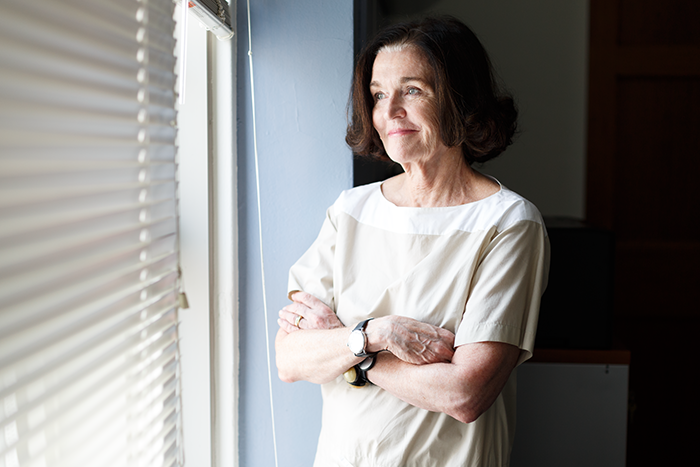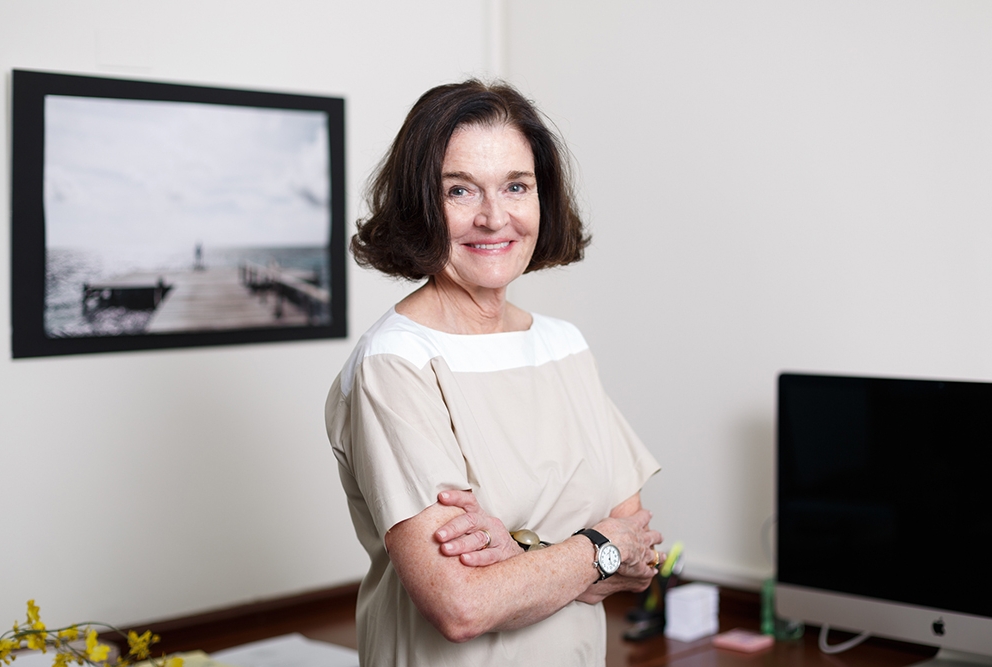Driven by the desire to help older adults continue making important contributions to society, Dr. Sara Czaja has dedicated her career to helping people “successfully age.”
“One does not stop learning or growing intellectually, cognitively and emotionally at their 65th birthday,” said Dr. Czaja, one of the world’s top experts on technology and aging who was recently recruited to Weill Cornell Medicine as a professor of gerontology in medicine from the University of Miami Miller School of Medicine. “We need to find ways to maximize the contributions of this population, while ensuring their quality of life and independence.”
That’s exactly what Weill Cornell Medicine’s newly established Center on Aging and Behavioral Research seeks to do. As the center’s inaugural director, Dr. Czaja and her team are developing and testing innovative strategies and interventions that strive to keep older adults independent and engaged, socially, intellectually and even professionally. Much of these efforts, which Dr. Czaja began at the University of Miami and are funded by the National Institutes of Health, focus on how technology can be adapted to improve older adults’ health and wellbeing. The result: 90 year olds have learned how to surf the Internet, send emails and play computer games.
“These are really wonderful successes,” Dr. Czaja said. “They refute the notion that older people are technophobic and can’t learn.”
A Buffalo native, Dr. Czaja is an engineer and psychologist who spent nearly 30 years at the University of Miami before joining Weill Cornell Medicine’s faculty.
“Weill Cornell Medicine has a fabulous reputation, and I am thrilled to be here,” she said. “I like the people here tremendously; there’s a strong sense of collegiality and camaraderie. I’m from upstate New York, so relocating here is like coming home.”
We sat down with Dr. Czaja to learn more about the center and the innovative ways she’s helping older adults age with dignity.
We hear constantly that the United States’ population is aging. What does that mean in a practical sense?
Not only is the population aging, but we’ve also seen a big increase in the number of people who are referred to as the “oldest old,” people who are 85-plus. But, in general, people typically define older adults as those 65 and older. There are challenges in terms of providing adequate support systems for this population, ensuring that they’re able to remain independent as long as possible and enjoy a good quality of life. For example there is a higher prevalence of chronic conditions among this demographic, which presents enormous challenges for the healthcare system. There are also challenges in terms of affordable living communities and transportation systems that support older adults.
Aging is a natural part of life, so why is this moment different?
I think because of the sheer numbers. By 2040, an estimated 80 million people in the United States—some 21 percent of our total population—will be over the age of 65. And I think also that current and future cohorts of older adults are and will continue to be much more diverse—culturally, ethnically, in terms of life experiences and backgrounds—and in general, on some measures, healthier than previous generations. They are also better educated and want to remain active. That really changes the landscape of aging.
An aging population also means an aging workforce. If this generation wants to stay active, how can we support them?
Many older people want to remain productively engaged in the workforce, so we need to figure out ways to support and maximize their contributions. This is a big topic that’s starting to emerge, not just for economic reasons but also because many older adults want to continue to work, and importantly because older adults can make significant contributions in the workplace. Technology is playing a large role in today’s work environment. For example, tele-work is a very good option for older people who want to work part-time or cannot physically get to a workplace. Technology-based jobs tend to also be much less physically demanding. Unfortunately, problems with skill obsolescence confront many older adults. Although there are opportunities for workers to gain the skills they need to work with technology, older adults are often bypassed for re-training opportunities.

Does this moment also offer opportunities?
I think there are tremendous opportunities. Older adults have skills, they have experience; there’s a lot that can be done in terms of knowledge transfer, peer-to-peer interaction, mentoring and teaching. Wisdom. Creativity. Those things are often overlooked in our youth-oriented society, but I think that picture is also starting to change.
What is your vision for the Center on Aging and Behavioral Research and what do you hope to achieve with it?
Our center has several aims. One is certainly to conduct research that addresses both challenges and opportunities for older adults and their families. For example, we currently are doing research, funded by the National Institute on Aging (NIA), with the University of Pittsburgh that is examining factors, such as numeracy, literacy, cognition and demographics, that predispose older adults to financial exploitation. We are going to recruit 360 older people here in New York for that project. Another project will focus on an exercise and social support intervention for sedentary older people who aren’t currently engaging in physical activities. It has a social support component, so people will be in teams, and the exercises are geared for things they can do at home. We’re going to be recruiting about 200 people to participate.
We are also part of a multisite center, along with the University of Miami, University of Illinois Urbana-Champaign, Florida State University and Georgia Institute of Technology, called CREATE [Center for Research and Education for Aging and Technology Enhancement] that’s been funded by NIH since 1999. Its focus is on aging and technology systems from two perspectives. The first is to ensure that older adults can realize the potential benefits of technology in terms of enhancing their independence and quality of life, and the second is making sure that technology systems are designed to accommodate the needs, preferences and abilities of older people.
I think there are wonderful research opportunities here, given the faculty and their expertise that’s available at Weill Cornell Medicine, the Ithaca campus and also Cornell Tech on Roosevelt Island, because a lot of our work involves the use of technology to bring programs and services to older adults.
Another aim I have is to form strong community partnerships. Community partnerships are really important because we want to understand what the community needs and to draw community participants from diverse populations into our research. What we’ve learned early on in our work is that one size does not fit all. So, for example, a caregiver intervention may need to be tailored slightly for Latino or African-American caregivers as compared to Caucasian caregivers, because of different cultural norms, different beliefs, different ideas about family. And we must consider diversity not just in terms of culture and ethnicity, but also socio-economic status, living arrangements, health status and sexual orientation.
We will also strive to forge collaborations with other institutions. We’ve already done that with CREATE, and we are hoping to do the same with our Center on Aging and Behavioral Research.
What is the value of technology in assisting older adults? What are some of the projects in CREATE’s portfolio?
It’s important to recognize that technology is not a solution, it’s a part of a solution. We’ve used technology very effectively, for example, to bring evidence-based programs to family caregivers in their home. We’ve also just completed the first part of a randomized trial (PRISM) for which we designed a software system, in consultation with older adults, that is extremely easy to use. We installed the software onto computers that we then gave to 150 older adults, 65-90 years old, who were isolated, lived alone and didn’t have computer experience. Participants learned how to use email, were able to communicate with their grandchildren, navigate the Internet and share photos. The findings indicated that those who had the system reported being less lonely and having more social support than those in the control group. Computer technology offers a great deal in terms of fostering social connectivity, social engagement, opportunities for new learning—there are a lot of online courses now. Tele-work is a good way for people who have mobility restrictions to remain employed. But if we’re going to use technology, for example, to enhance social engagement, it’s with the caveat that it doesn’t replace human engagement and face-to-face activity. So I think there has to be a balance.
You stressed the importance of older adults’ caregivers. What role can healthcare professionals play to ensure that they, too, have the resources and support they need to help their loved ones and also maintain a good quality of life?
I think the big thing is recognizing caregivers and their role and contributions. There’s often a lot of focus on the patient—which, of course, needs to happen—without looking at the needs of the person who is caring for the patient. I think there’s a lot we can do in terms of providing caregivers with educational and emotional support. And that’s actually the point of one of our projects, which we are about to launch here and in Miami.
For the Care Partners Program, we will deliver an evidence-based intervention to family caregivers of early-stage Alzheimer’s patients and another intervention to the patients themselves. We’re doing it in participants’ homes using technology. Our intervention is designed to help prepare people for the caregiving role, what to expect in the future, how to deal with their emotional stress and stress management, trying to get them to engage in pleasant events, and teaching them ways to do that. So it’s really to provide support for the caregiver as well as help alleviate their burden and stress, which in turn improves their quality of life. And that has an impact on the patient’s quality of life.
In addition to your research, you’re also a teacher and a mentor. Why is it important to nurture talent in this healthcare area?
Another big goal of the Center on Aging and Behavioral Research is to mentor and train students and junior faculty. We need to train a cadre of new people so that they gain research expertise, grow into independent research scientists and are able to continue this important work.

